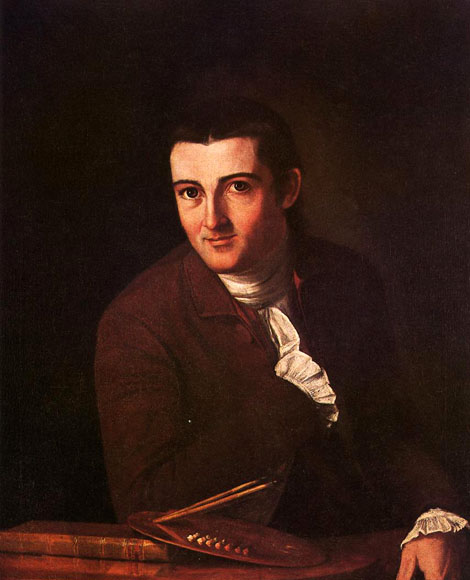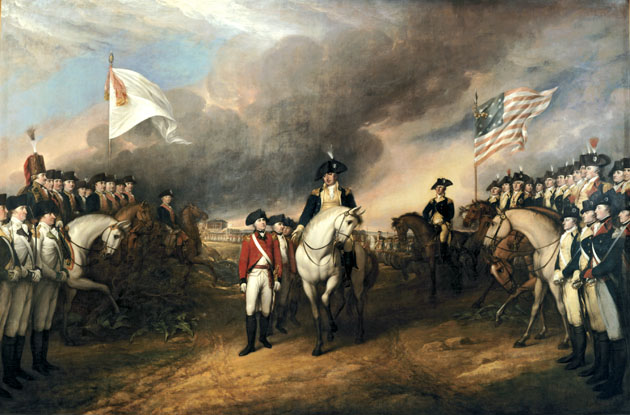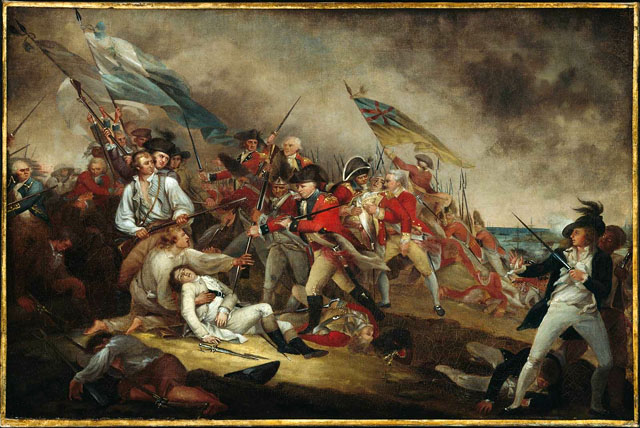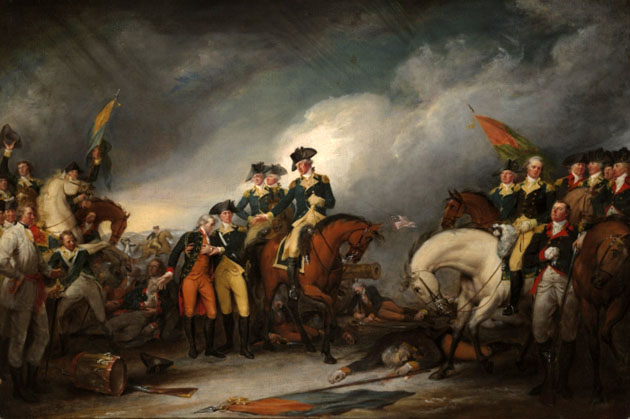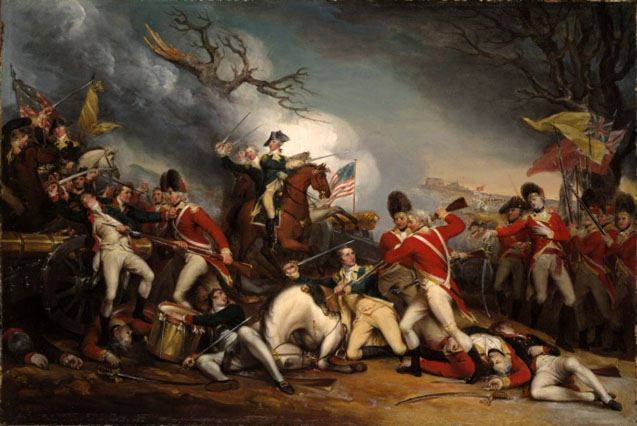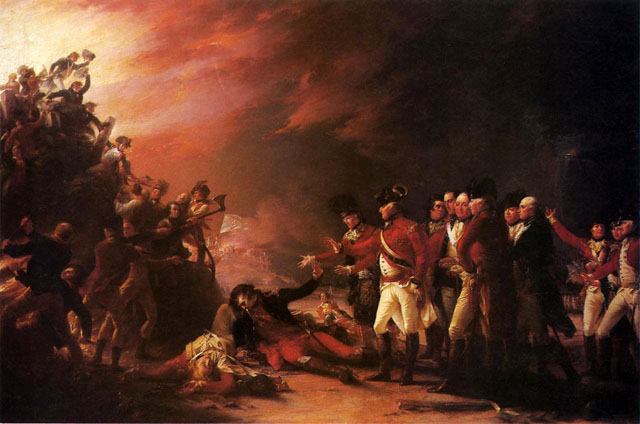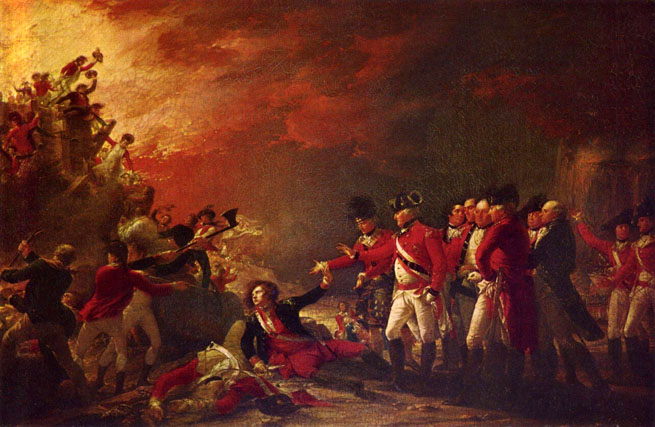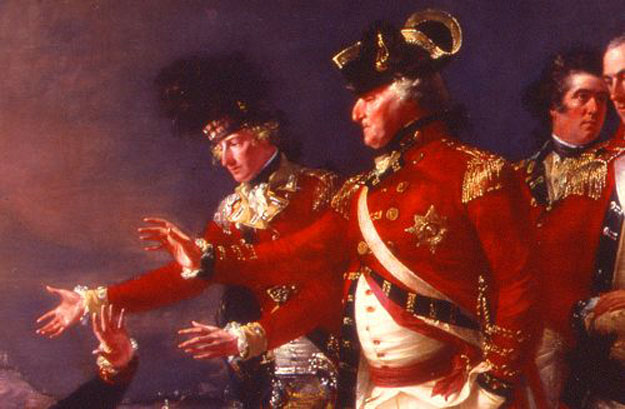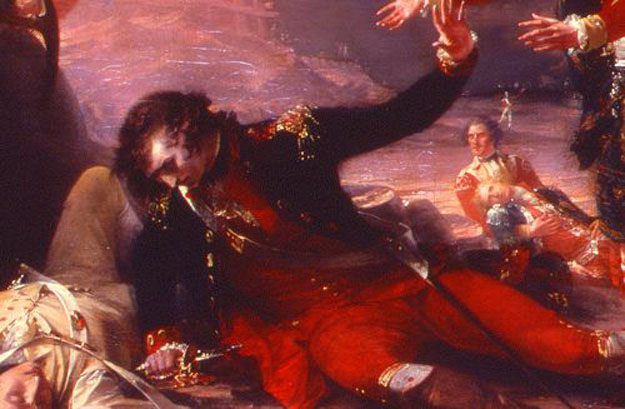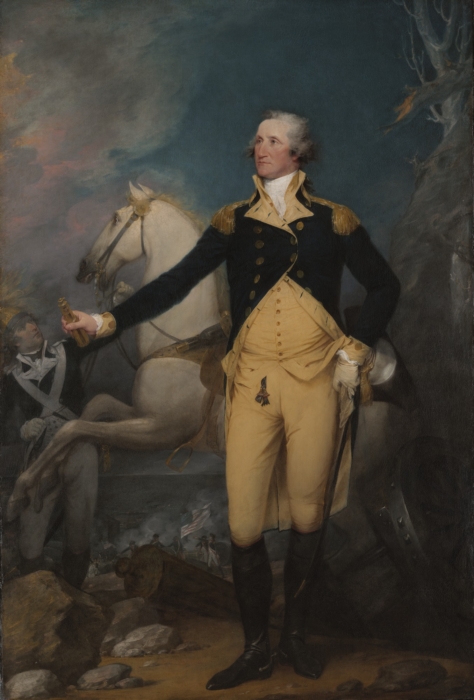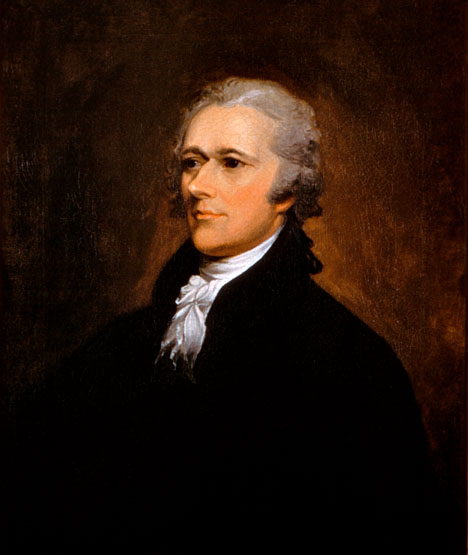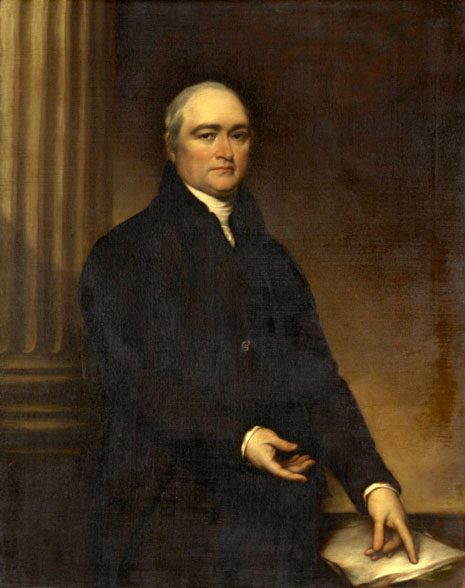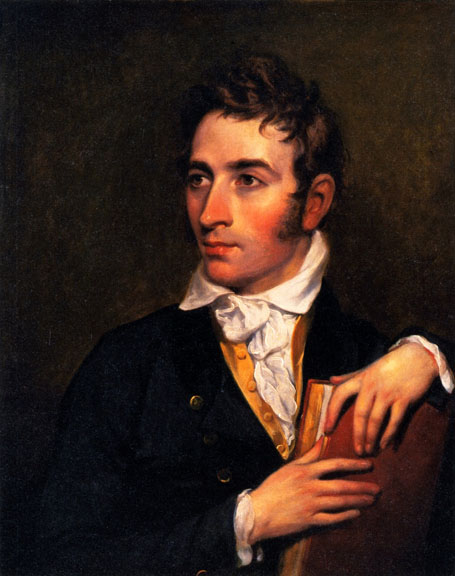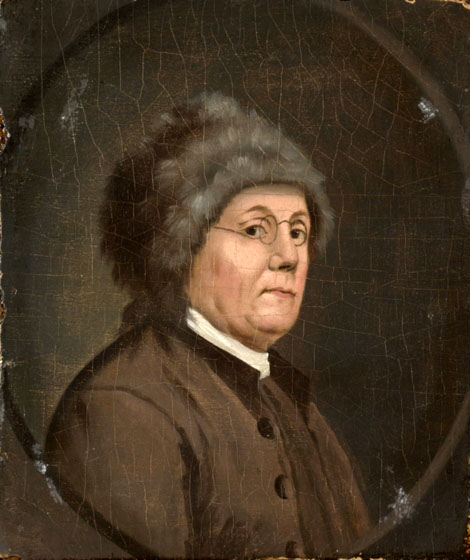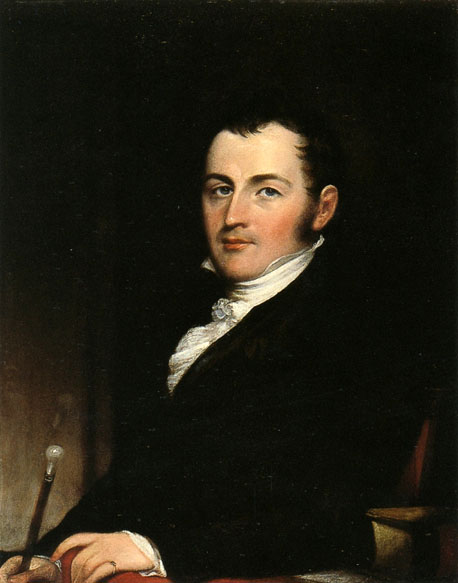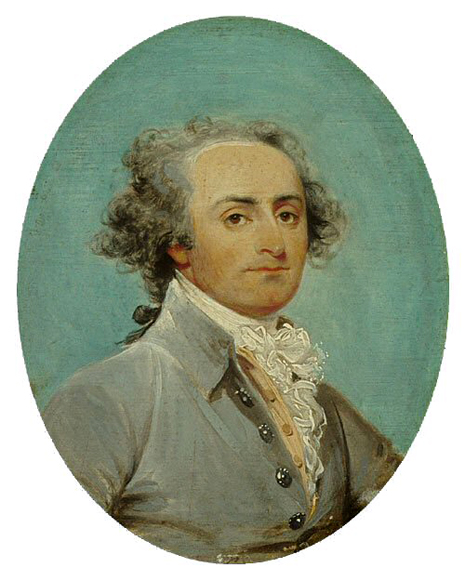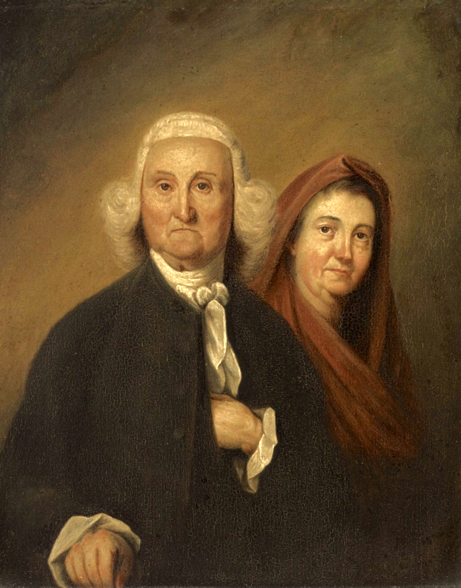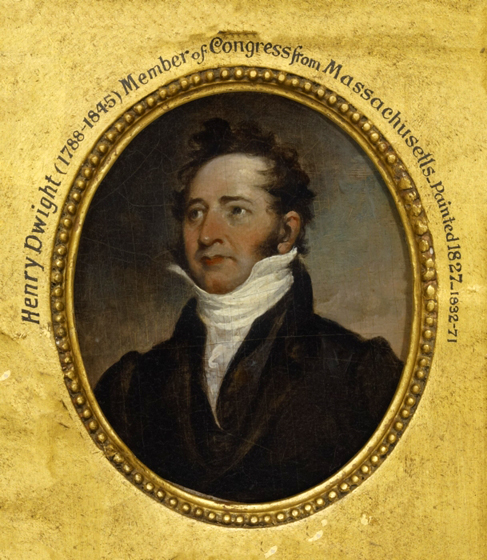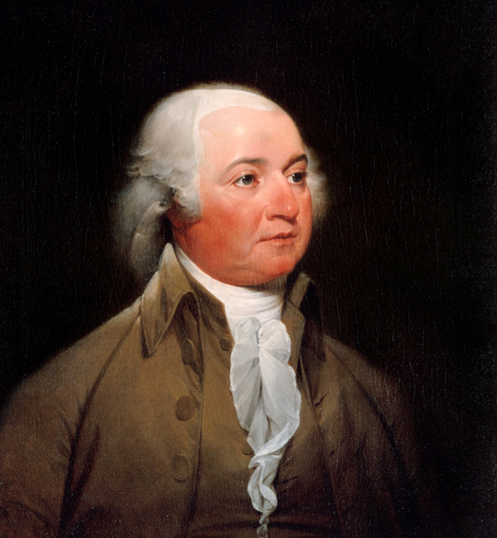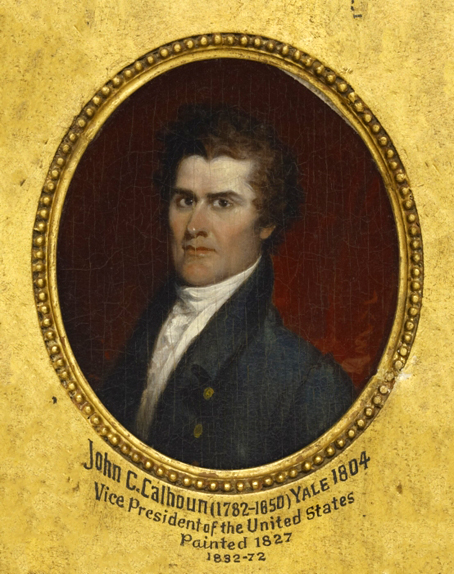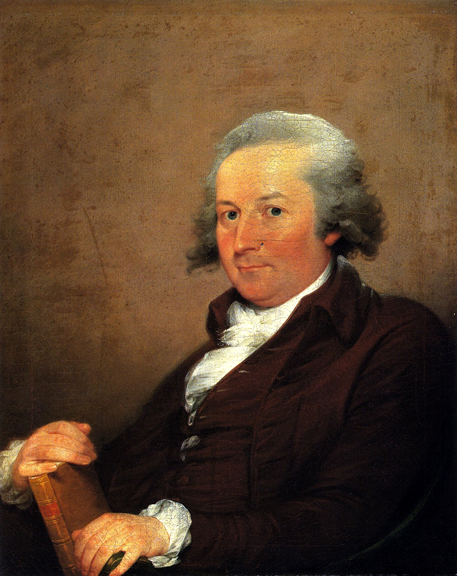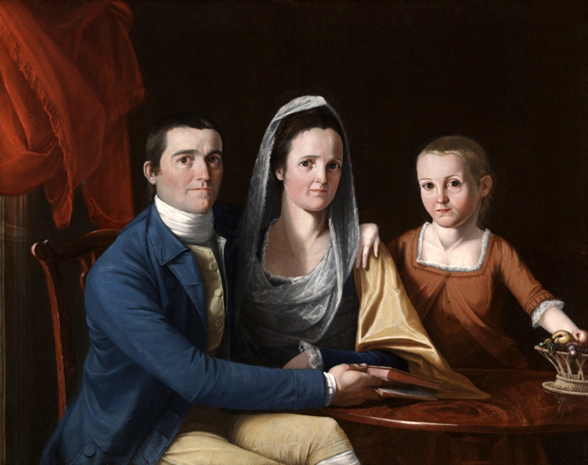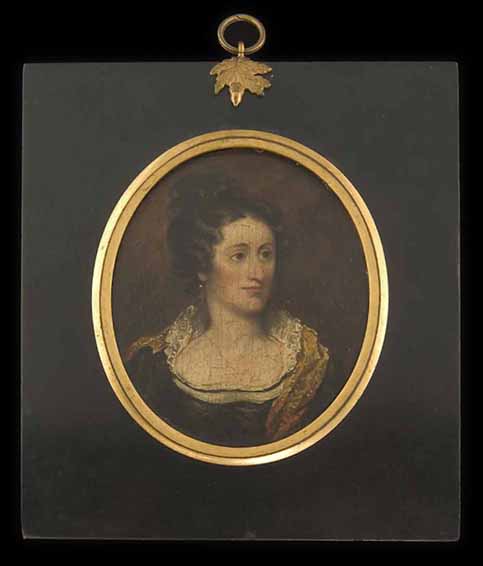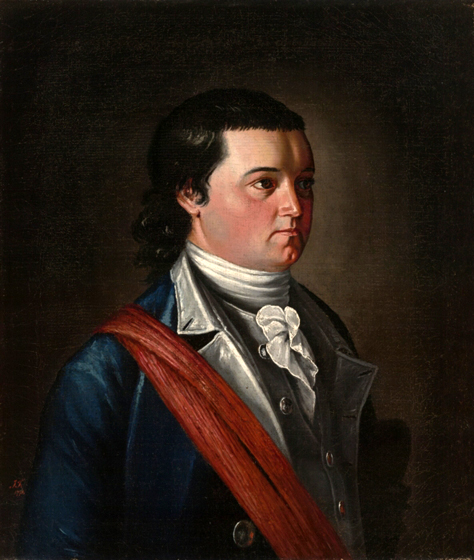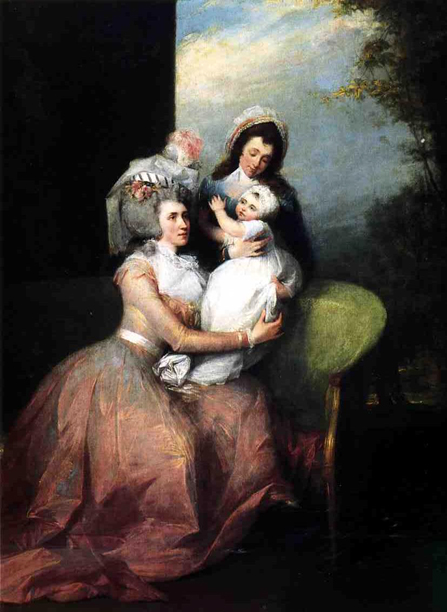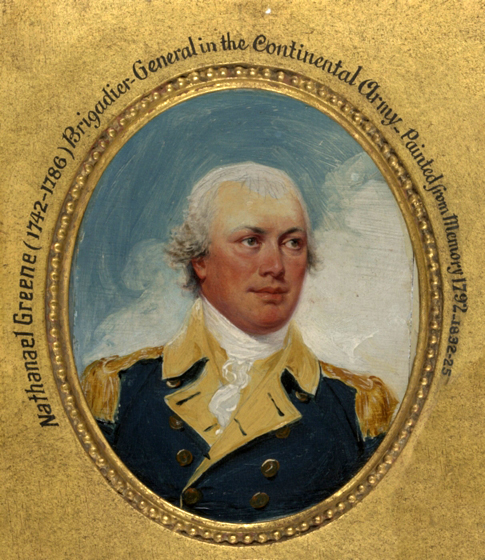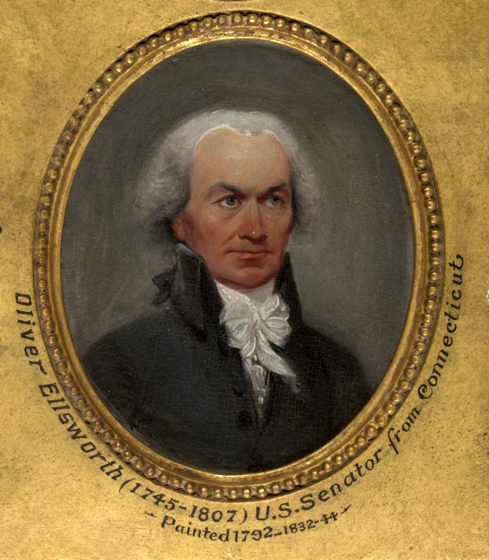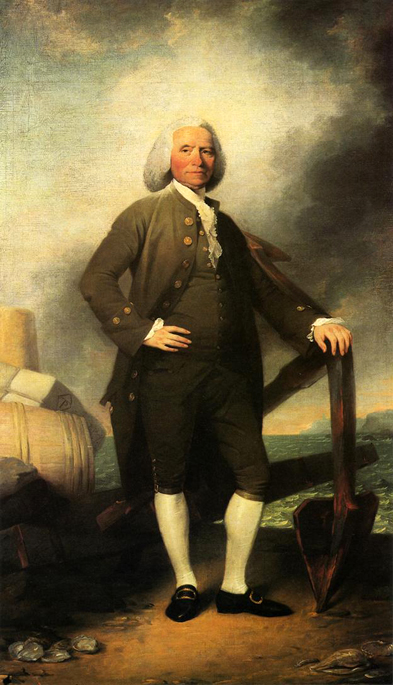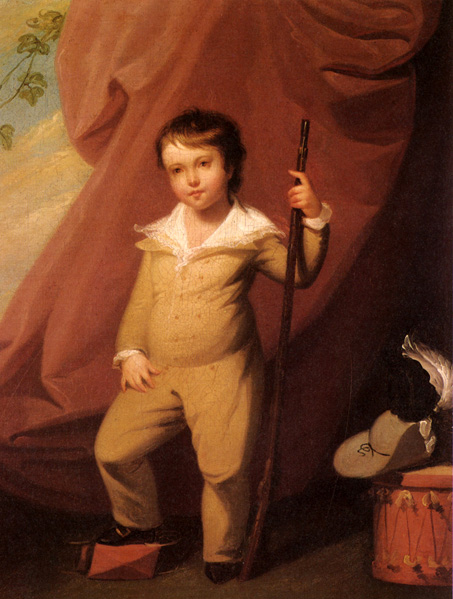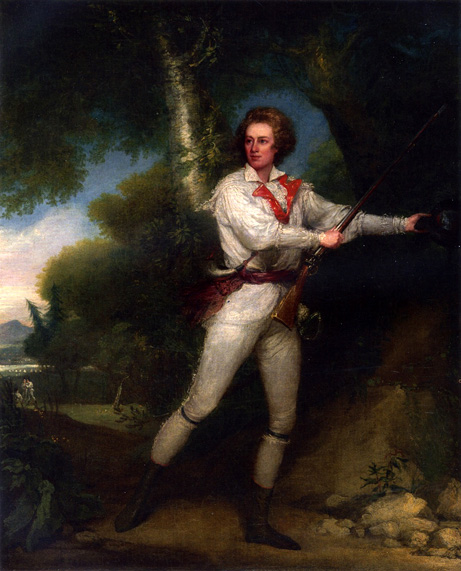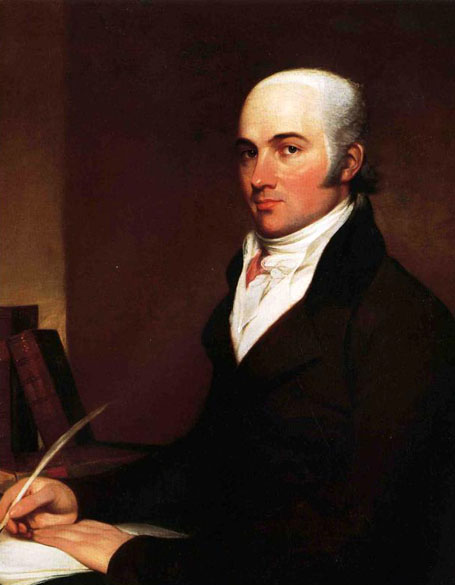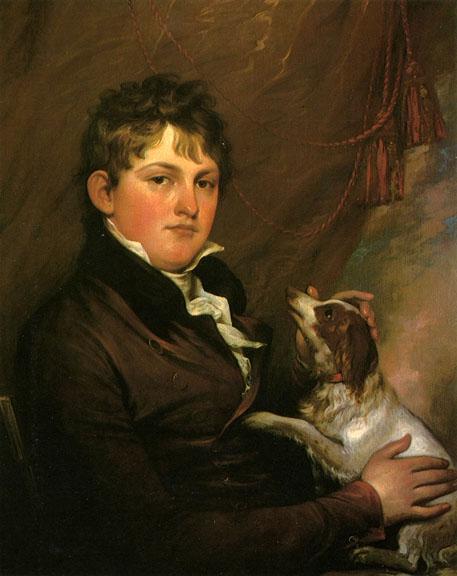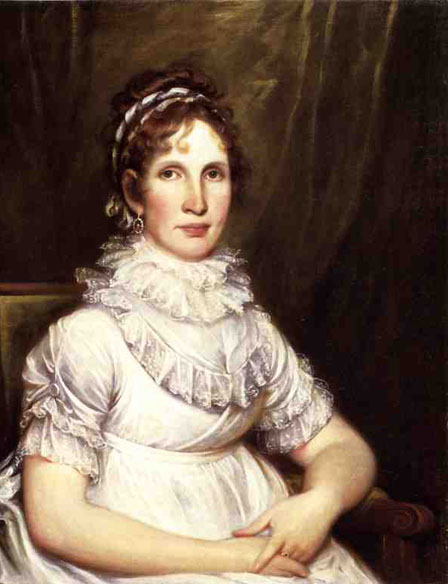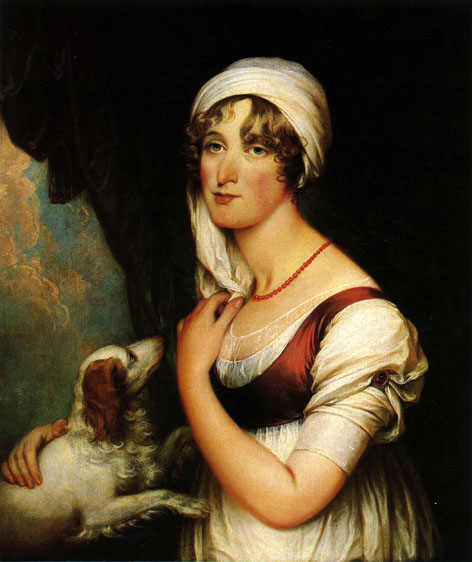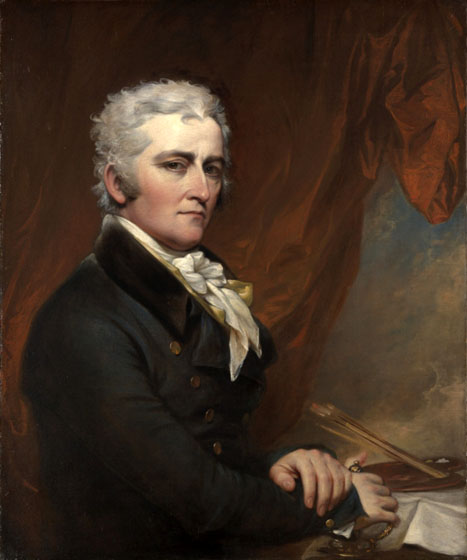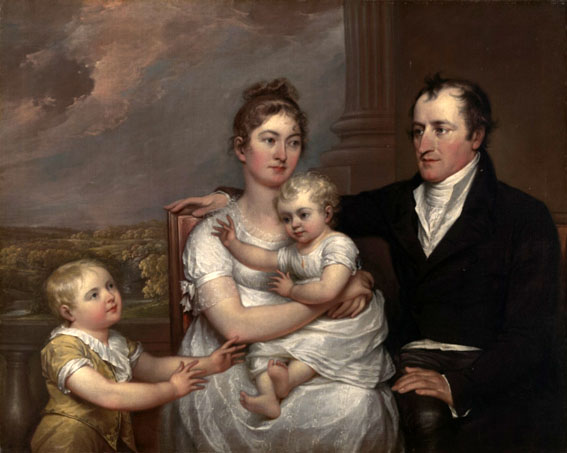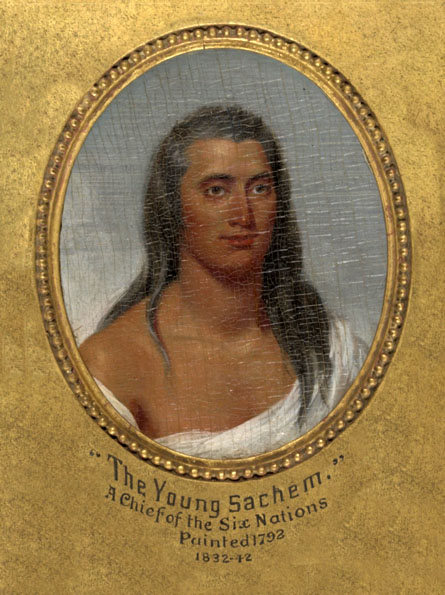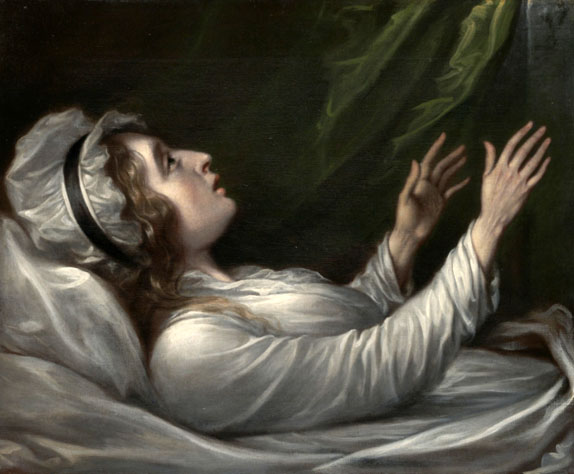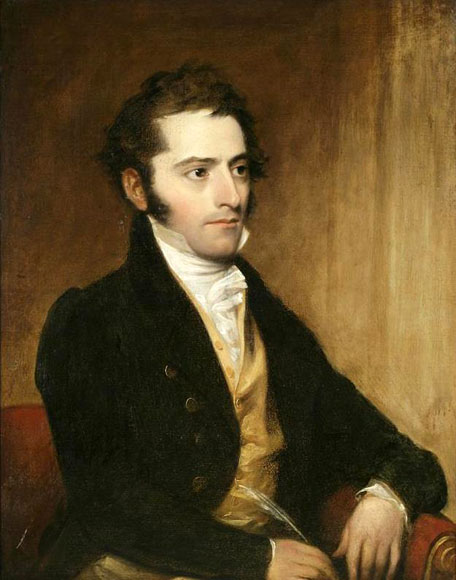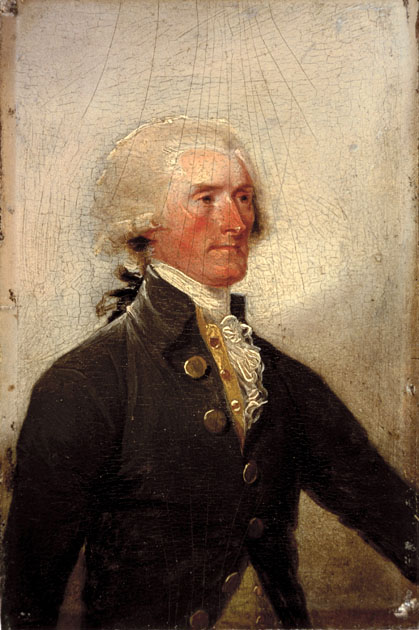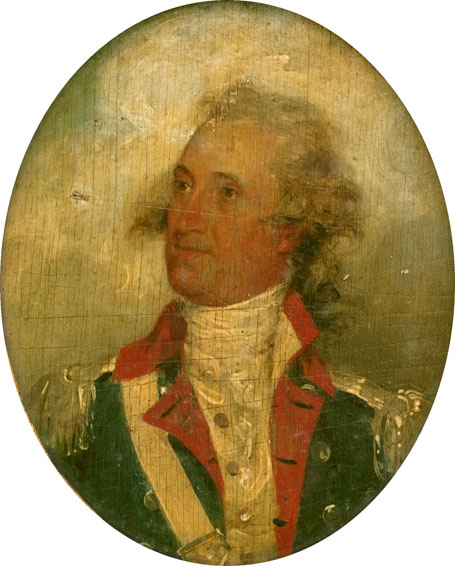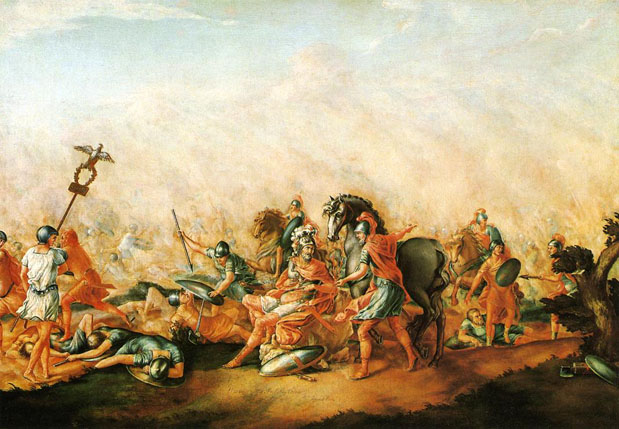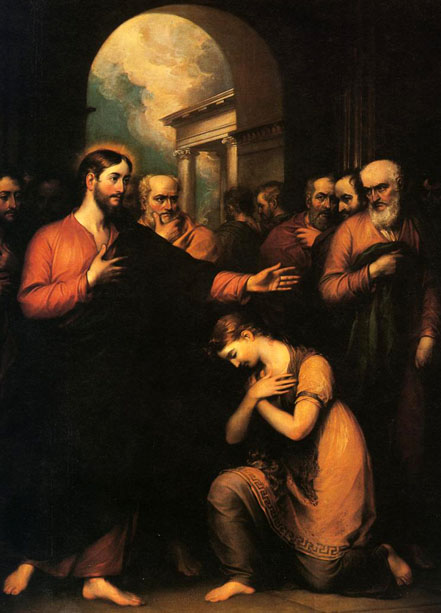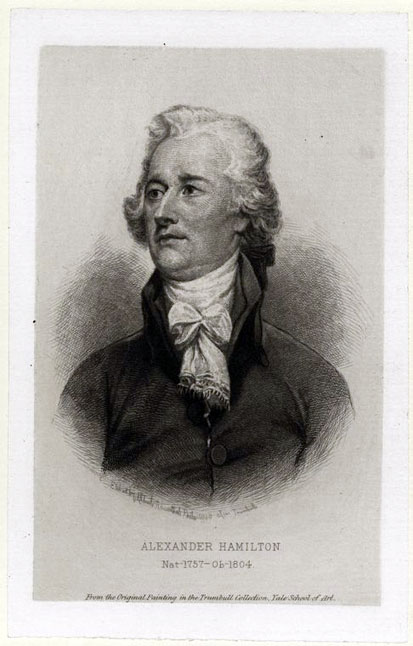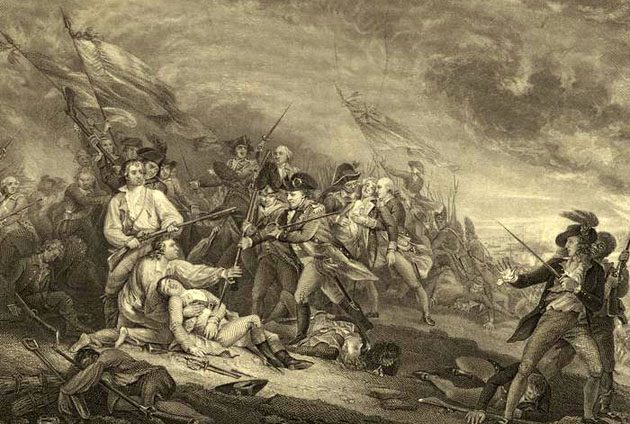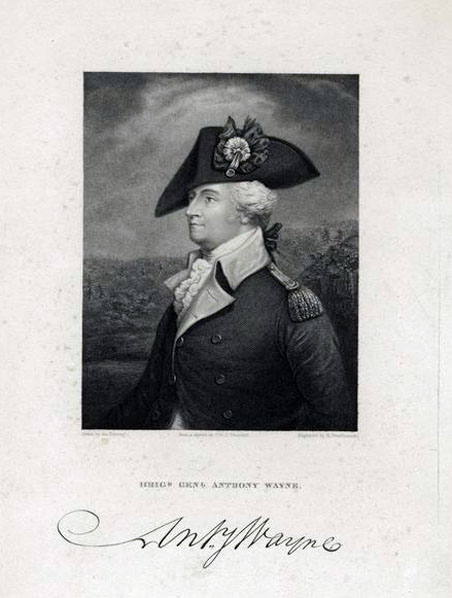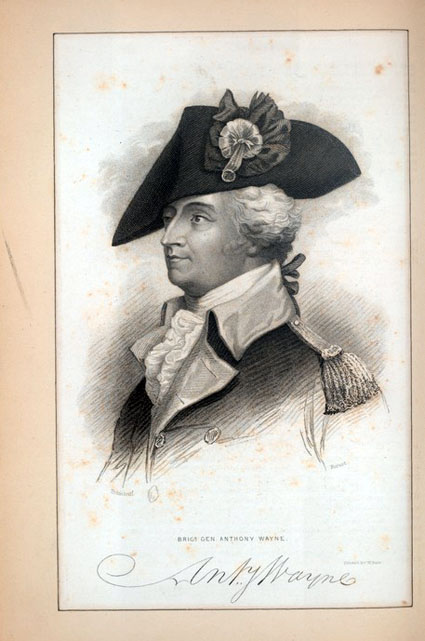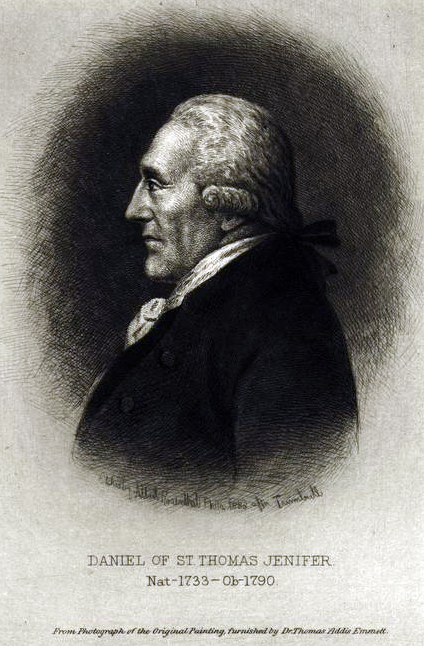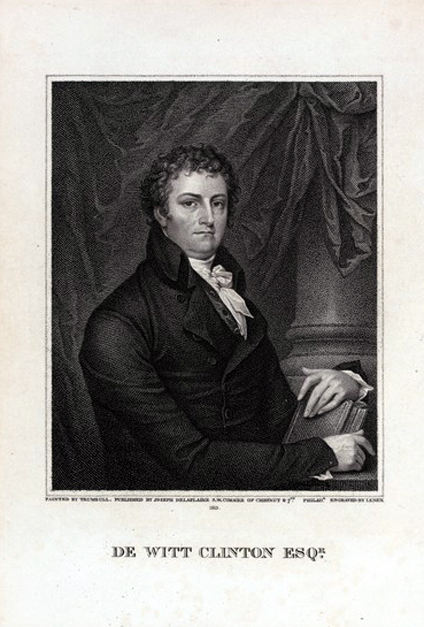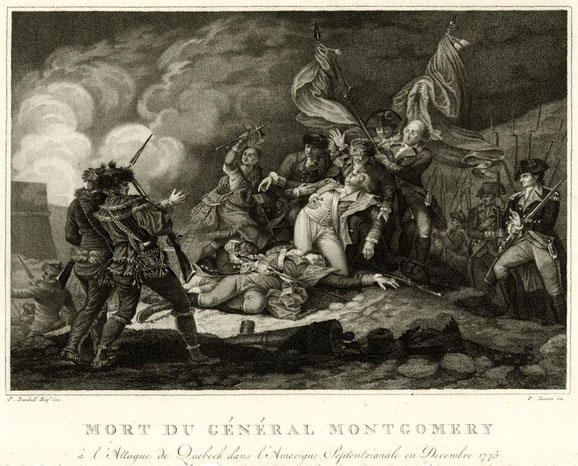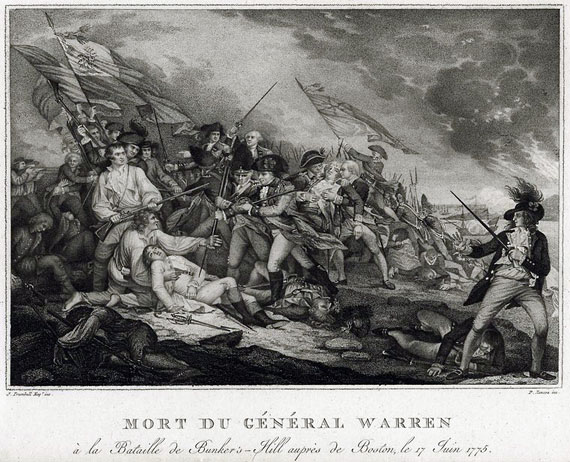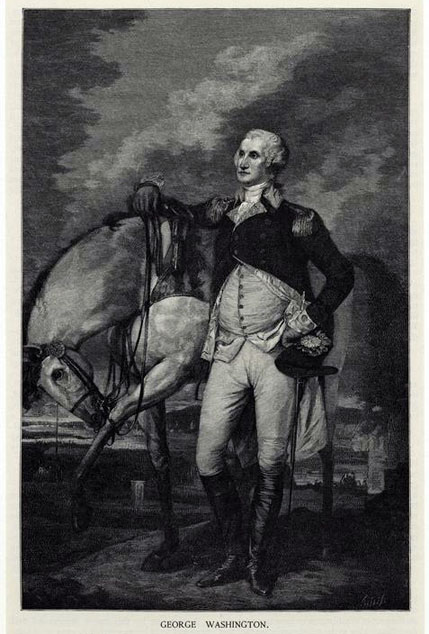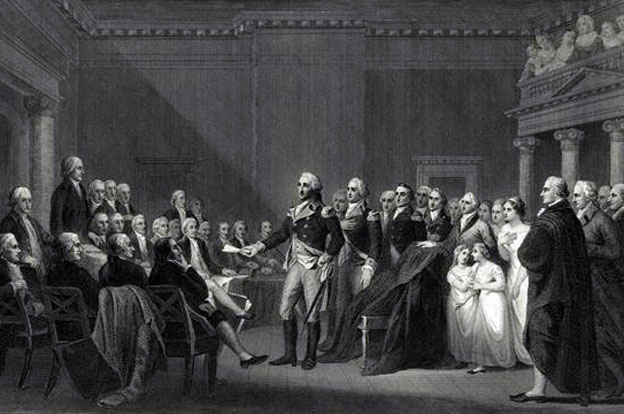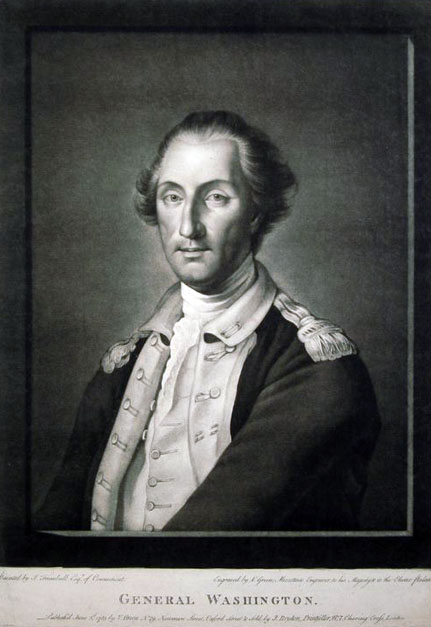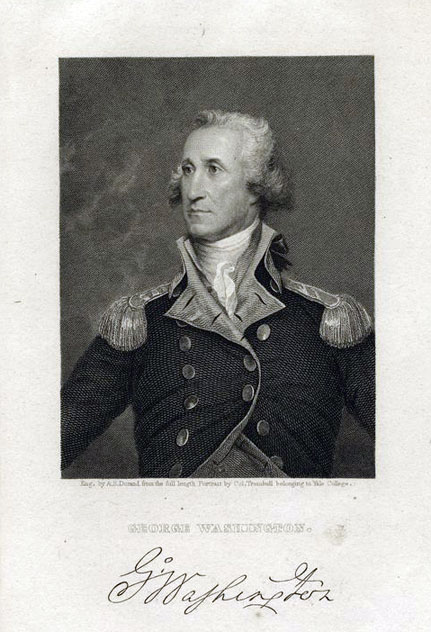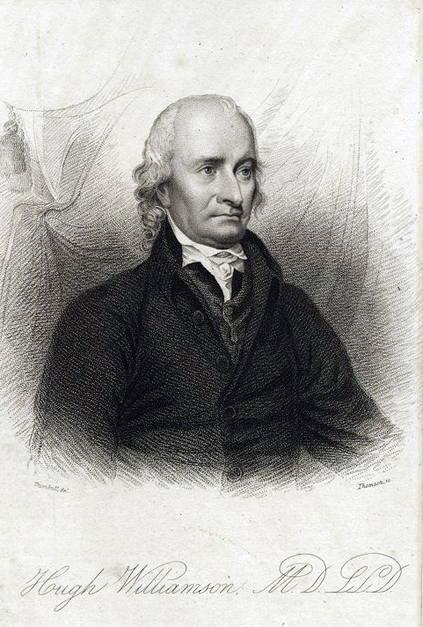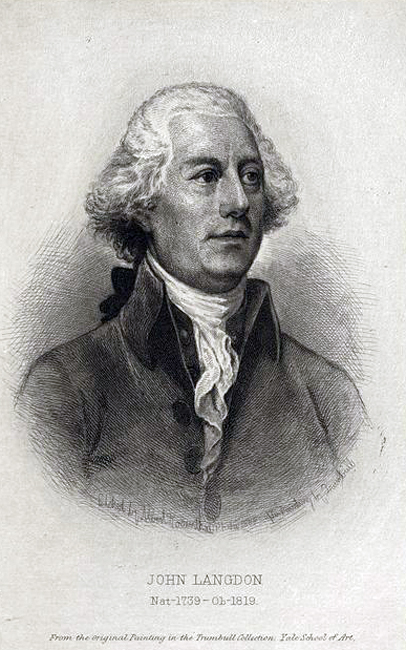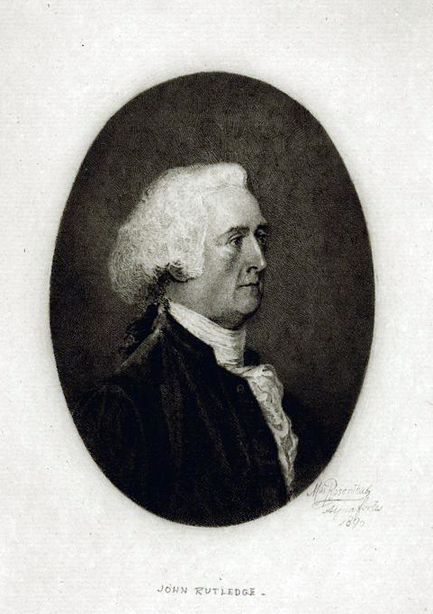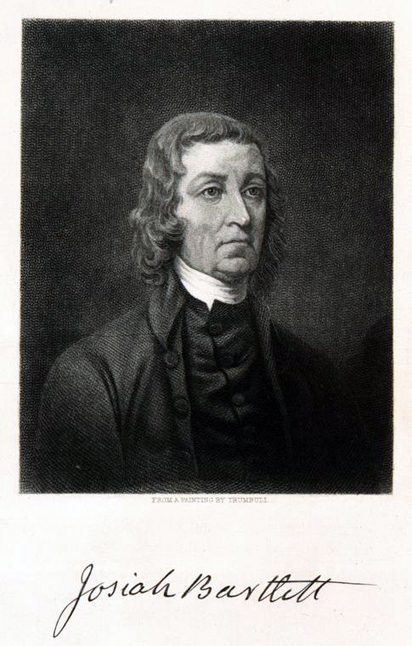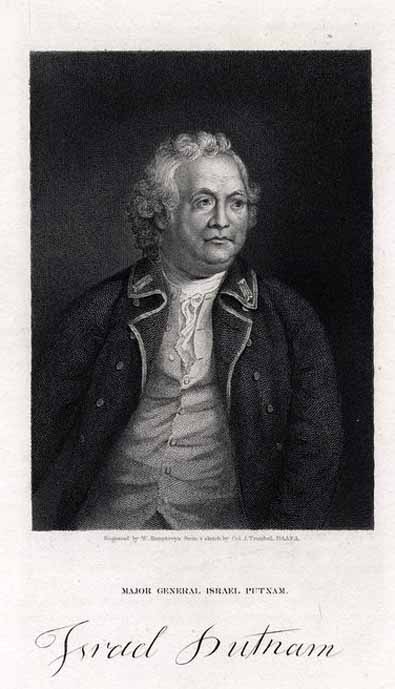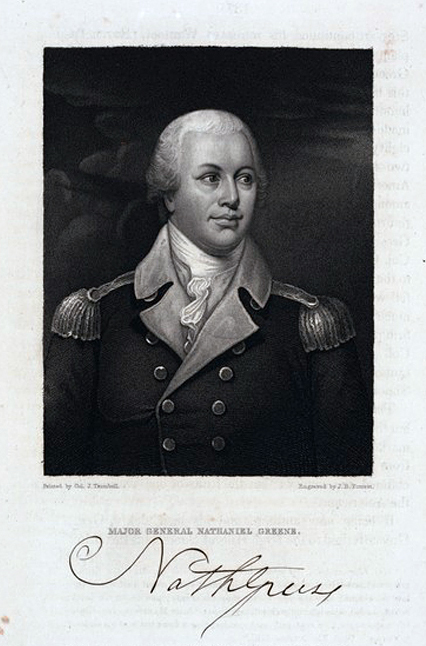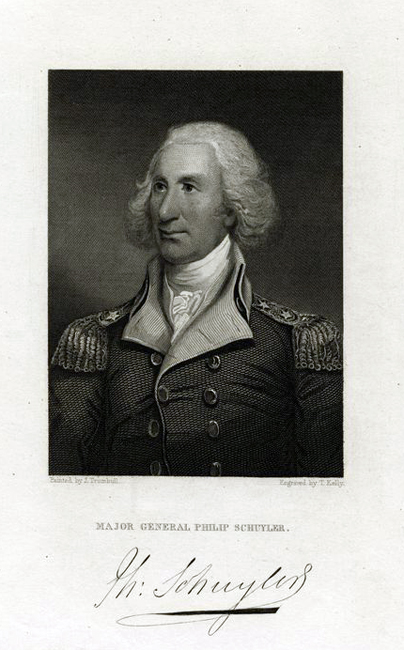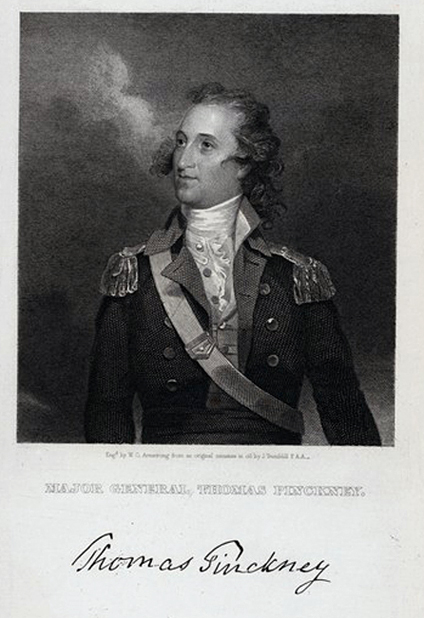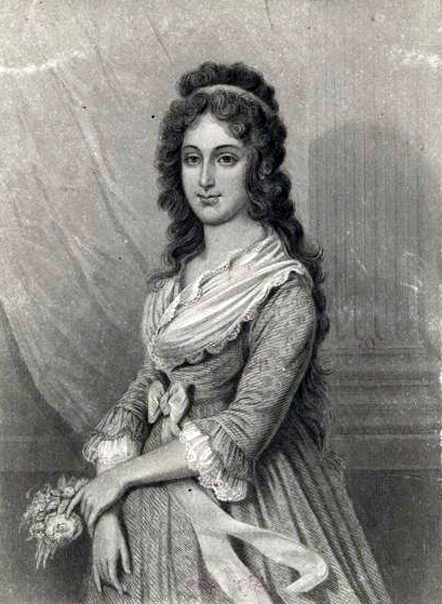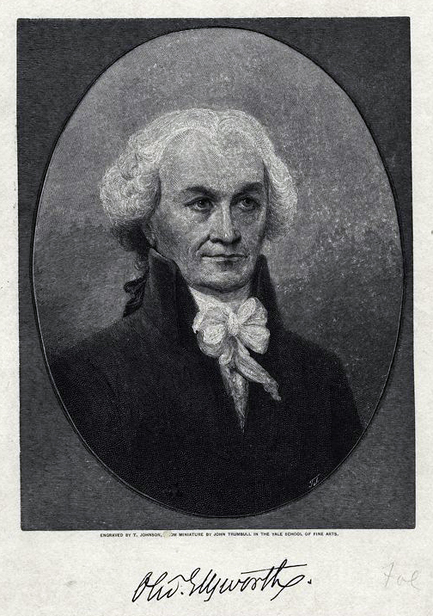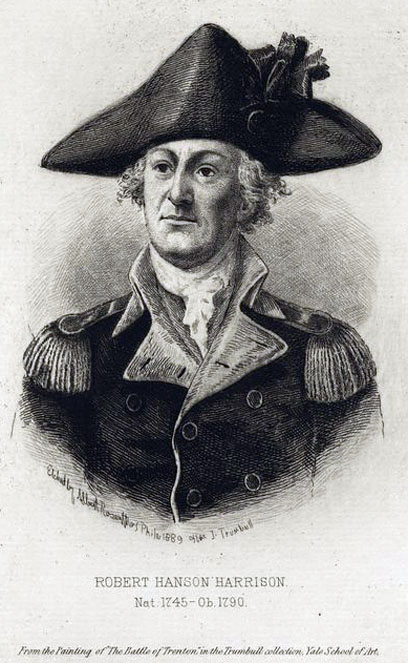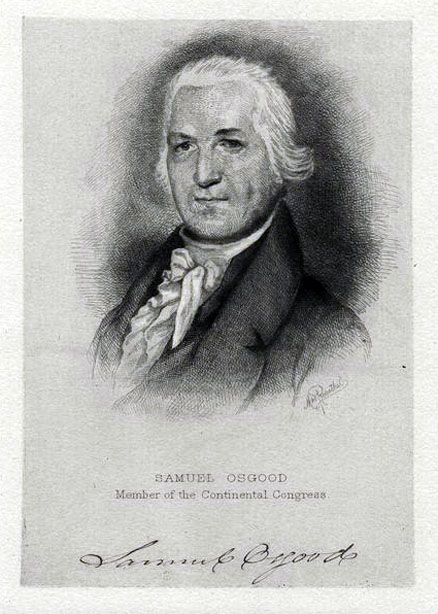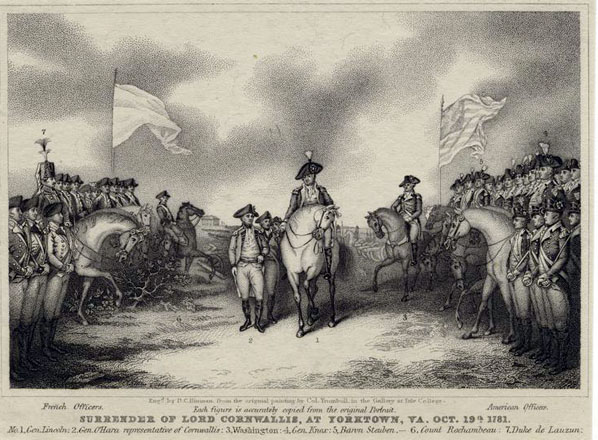Disclaimer
John Trumbull
American Neoclassical Painter
1756 - 1843
Self Portrait: 1777
John Trumbull was an American artist during the period of the American Revolutionary War and was notable for his historical paintings. His 'Declaration of Independence' (1817) was used on the reverse of the two-dollar bill.
Declaration of Independence: 1819
Trumbull was born in Lebanon, Connecticut, in 1756, to Jonathan Trumbull, who was Governor of Connecticut from 1769 to 1784, and his wife Faith Robinson Trumbull. He entered the 1771 junior class at Harvard University at age fifteen and graduated in 1773. Due to a childhood accident, Trumbull lost use of one eye, which may have influenced his detailed painting style.
As a soldier in the American Revolutionary War, Trumbull rendered a particular service at Boston by sketching plans of the British works, and witnessed the
Battle of Bunker Hill. He was appointed second personal aide to General George Washington, and in June 1776, deputy adjutant-general to
General Horatio Gates. He resigned from the army in 1777.
In 1780 he traveled to London, where he studied under
Benjamin West. At his suggestion, Trumbull painted small pictures of the War of Independence and miniature portraits, of which he produced about 250 in his lifetime.
On September 23, 1780, British agent Major
John André was captured in America and was hanged as a spy on October 2, 1780. News reached Europe, and as an officer of similar rank as André in the Continental Army, Trumbull was imprisoned for seven months in London's
Tothill Fields Bridewell.
In 1784 he was again in London working under West, in whose studio he painted his Battle of Bunker Hill and Death of General Montgomery at Quebec. Both works are now in the Yale University Art Gallery.
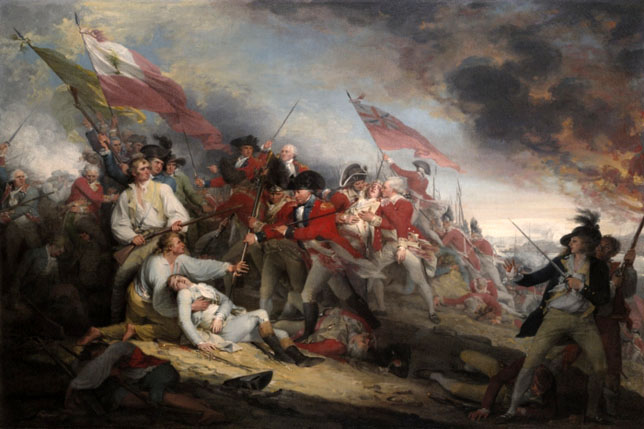
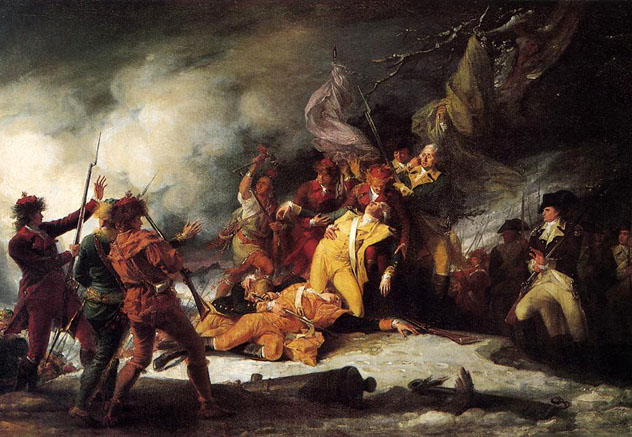
In 1785 Trumbull went to Paris, where he made portrait sketches of French officers for
Surrender of Lord Cornwallis. With the assistance of Thomas Jefferson, he began
Declaration of Independence, well-known from the engraving by
Asher Brown Durand. This latter painting was purchased by the
United States Congress, along with his
Surrender of General Burgoyne,
Surrender of Lord Cornwallis, and
Washington Resigning his Commission. All now hang in rotunda of the United States Capitol. Allegedly because Congress only voted enough money for four paintings, only these four of Trumbull's paintings on the Revolution are hung there. Not hung were
Death of General Warren at Bunker Hill;
Death of General Montgomery at Quebec;
Capture of Hessians at Battle of Trenton;
Death of General Mercer at Battle of Princeton. Trumbull's
The Sortie Made by the Garrison of Gibraltar, 1789, owned by the
Boston Athenaeum, is now in the
Metropolitan Museum of Art in New York City. While in Paris, Trumbull is credited with having introduced Thomas Jefferson to the Italian painter
Maria Cosway, who would turn out to become an intimate friend of his for the rest of his life.
In the Rotunda of the United States Capitol
Surrender of General Burgoyne
This painting depicts General John Burgoyne prepared to surrender his sword to General Horatio Gates. Gates, showing respect for Burgoyne, refuses to take the sword and instead offers hospitality by directing Burgoyne to the tent to take refreshment; the American flag flies in the wind at the top of the tent. American officers gather at the sides to witness the event; their varied dress reflects their different units. In the center of the painting, and extending into the background, is Burgoyne's army along with its German reinforcements. They were directed to the camp by American Colonel Lewis, Quartermaster-General, who rides on horseback in the far distance. The scene suggests peace rather than combat or hostility: beneath blue sky and white clouds, officers wear their dress uniforms, weapons are sheathed or slung, and cannons stand silent.
Surrender of Lord Cornwallis
In the center of the scene, American General Benjamin Lincoln appears mounted on a white horse. He extends his right hand toward the sword carried by the surrendering British officer, who heads the long line of troops that extends into the background. To the left, French officers appear standing and mounted beneath the white banner of the royal Bourbon family. On the right are American officers beneath the Stars and Stripes; among them are the Marquis de Lafayette and Colonel Jonathan Trumbull, the brother of the painter. General George Washington, riding a brown horse, stayed in the background because Lord Cornwallis himself was not present for the surrender.
Surrender of Lord Cornwallis in the Capitol Rotunda is one of two paintings that artist John Trumbull completed on this subject. He painted this version between 1819 and 1820, basing it upon a small painting (approximately 20 inches by 30 inches) that he had first envisioned in 1785, when he began to "meditate seriously the subjects of national history, of events of the Revolution." In 1787 he made preliminary drawings for the small painting. Although he struggled for a time with the arrangement of the figures, he had settled upon a composition by 1788.
Washington Resigning his Commission
Washington, illuminated by the light falling into the room, stands in uniform before the president of the Continental Congress, Thomas Mifflin, and the delegates, among whom is Thomas Jefferson. Behind Washington are his aides-de-camp, Col. Benjamin Walker and Col. David Humphreys, and spectators. The delegates and spectators direct their attention to Washington as he extends his right hand to return his commission. The empty chair draped in a cloak, suggestive of a throne covered with a king's robe, symbolizes Washington's act of retiring from his position of power.
General George Washington Resigning His Commission, painted between 1822 and 1824, was the last of the four paintings that John Trumbull created under his 1817 commission from the U.S. Congress. To depict accurately the figures in the painting, Trumbull copied miniatures he had painted previously, studied portraits by fellow artists, and contacted members of Congress for portraits of the delegates. He based the representation of George Washington on one of his own earlier portraits. Some figures not present at the actual event are shown, including James Madison and Martha Washington and her grandchildren, who appear in the gallery. Trumbull visited and sketched the room, the Senate Chamber of the State House, in 1822, but in creating the painting he altered some elements. The Chamber no longer contained the furnishings used at the time of Washington's resignation. Rather than depict the newer furniture created for the room in 1796, Trumbull copied the chairs he had painted in Declaration of Independence; Washington's larger chair differs from those in which the delegates are seated, which contributes to the suggestion of a throne. The painting was completed in April 1824, and Trumbull took it on tour during the rest of the year in Boston, Providence, Hartford, Albany, Philadelphia, and New York City.
Not Bought by Congress and Found Elsewhere
The Death of General Warren at Bunker Hill: 1776
Called in his day the "patriot-artist," John Trumbull served in the Continental Army from 1775 to 1777 and became known for his images of the Revolutionary War-a prime source of material for contemporary history paintings. After resigning his commission, he went to London to study with Benjamin West, returning to the United States with the plan to immortalize the country's struggle for independence in a series of paintings based on the critical events of the conflict and thus create to a new iconography for the new nation. He ultimately completed eight compositions, and in 1817 Congress awarded him a commission for four large canvases to decorate the United States Capitol.
The Death of General Warren at the Battle of Bunker's Hill, 17 June 1775 was the first Revolutionary War subject that Trumbull completed. (The scene was not chosen for the Capitol, however.) Joseph Warren, perhaps today less well known than Paul Revere, John Hancock, or Samuel Adams, was one of the key players in the events leading up to the outbreak of war. A popular and innovative physician-among other things, he advocated inoculation and cleanliness in the treatment of his patients-Warren plunged into politics in the late 1760s as an author of persuasive anti-Crown literature, an orator of eloquent speeches, and an underground leader of the growing revolutionary movement. He accepted a commission as a major general on June 14, 1775, but it was as a volunteer that he was killed three days later at the Battle of Bunker Hill.
The Death of General Montgomery at Quebec
The Capture of the Hessians at the Battle of Trenton
Death of General Mercer at Battle of Princeton
At the Boston Athenaeum
The Sortie Made by the Garrison of Gibraltar, 1789
A Slightly Different View
The Sortie Made by the Garrison of Gibraltar (Detail)
The Sortie Made by the Garrison of Gibraltar (Detail)
Trumbull sold a series of 28 paintings and 60 miniature portraits to Yale University in 1831 for an annuity of $1,000. This is by far the largest single collection of his works. The collection was originally housed in a neoclassical art gallery designed by Trumbull on Yale's Old Campus, along with portraits by other artists.
His portraits include full lengths of General Washington (1790) and George Clinton (1791), in New York City Hall, where there are also full lengths of Alexander Hamilton (1805), and the source of the face on the $10 bill) and John Jay, and portraits of John Adams (1797), Jonathan Trumbull, and Rufus King (1800); of Timothy Dwight and Stephen Van Rensselaer (both at Yale), Alexander Hamilton (in the Metropolitan Museum of Art and in the Boston Museum of Fine Arts, both taken from Ceracchi's bust), a portrait of himself painted in 1833, a full-length of Washington, at Charleston, South Carolina, a full length of Washington in uniform (1792), (now at Yale), and portraits of President and Mrs. Washington (1794), in the National Museum of American History.
George Washington - 1792: Princeton
By 1790 Trumbull was generally recognized as America's most accomplished painter of public portraits. In 1792 the city of Charleston, South Carolina, commissioned a large portrait of Washington for its city hall. All decisions regarding the time and place represented in the work, as well as its color, composition, and other details were left to the artist. Trumbull ambitiously undertook to make of this portrait a true history painting, representing a moment of supreme importance in the American Revolutionary War. Painted in Philadelphia, the seat of national government during Washington's presidency, the portrait shows Washington at Trenton, where he had devised a daring plan to slip away from the surrounding British troops by night and attack the enemy post at Princeton. Trumbull discussed with Washington the mood he wished to convey: We talked of the scene, its dangers, its almost desperation. He looked at the scene again, and I happily transferred to the canvass, the lofty expression of his animated countenance, the high resolve to conquer or to perish. Whether inspired by the renowned ancient Greek sculpture Apollo Belvedere or by a more ordinary statute of an orator, Washington's stance and gesture suggests the "noble grandeur" associated with classical sculpture in the late 18th century. The city of Charleston decided that the portrait was not suitable because it was more a history painting than a portrait. They preferred what they described as a more matter-of-fact likeness of Washington, a tranquil, peacetime image. Trumbull obligingly painted another version for the city and kept the first for himself. The portrait remained in his possession until the dissolution of the Society of the Cincinnati in Connecticut, of which he was a member, at which time it was presented to Yale College. In his autobiography Trumbull wrote that this portrait of Washington was the best, in my estimation, which exists, in his heroic military character.
Alexander Hamilton: 1805
Timothy Dwight IV
In 1794 Trumbull acted as secretary to John Jay in London during the negotiation of the treaty with Great Britain, and in 1796 he was appointed by the commissioners sent by the two countries the fifth commissioner to carry out the seventh article of the treaty.
Trumbull was appointed president of the American Academy of the Fine Arts, a position he held for nine years, from 1816 to 1825, though he did not get along with the students, and his skills declined. By 1825, his lack of support for the students led to the downfall of the Academy with the students rebelling and founding the National Academy of Design. He published an autobiography in 1841.
He died in New York City at the age of 87 on November 10, 1843. He was originally interred (along with his wife) beneath the Art Gallery at Yale University that he had designed. In 1867, his collection and remains were moved to the newly built Street Hall. The Trumbull Gallery was later razed.
The John Trumbull Birthplace in Lebanon, Connecticut, was declared a National Historic Landmark in 1965.
Various Works of John Trumbull
Asher Brown Durand: 1823
Benjamin Franklin: 1778
Christopher Gore: ca 1816
Christopher Gore was a prominent Massachusetts lawyer, Federalist politician, and U.S. diplomat. Born into a family divided by the American Revolution, Gore sided with the victorious Patriots, established a successful law practice in Boston, and built a fortune by purchasing Revolutionary government debts at a discount and receiving full value for them from the government.
Gore entered politics in 1788, serving briefly in the Massachusetts legislature before being appointed U.S. District Attorney for Massachusetts. He was then appointed by President George Washington to a diplomatic commission dealing with maritime claims in Great Britain. He returned to Massachusetts in 1804 and reentered state politics, running unsuccessfully for governor several times before winning in 1809. He served one term, losing to Democratic-Republican Elbridge Gerry in 1810. He was appointed to the US Senate by Governor Caleb Strong in 1813, where he led opposition to the War of 1812.
Gore invested his fortune in a variety of business endeavors, including important infrastructure projects such as the Middlesex Canal and a bridge across the Charles River. He was a major investor in early textile industry endeavors, funding the Boston Manufacturing Company and the Merrimack Manufacturing Company, whose business established the city of Lowell, Massachusetts. Gore was involved in a variety of charitable causes, and was a major benefactor of Harvard College, where the first library was named in his honor. His palatial mansion in Waltham, Massachusetts, now known as Gore Place, is one of the finest extant examples of Federalist architecture, and has been declared a National Historic Landmark.
George Gallagher, New York: 1826
Giuseppe Ceracchi: 1792
Giuseppe Ceracchi (also known as Giuseppe Cirachi) was an Italian sculptor, active in a Neo-classical style in Italy, England and the nascent United States, who was a passionate republican during the American and French revolutions. He is remembered for his portrait busts of prominent British and American individuals.
During his two American visits he executed heroic portrait busts of leaders of the American Revolution, including Benjamin Franklin (Pennsylvania Academy of Fine Arts), John Jay (Supreme Court, Washington DC), Thomas Jefferson (Monticello), George Washington with a Roman haircut and a toga (Metropolitan Museum of Art, George Clinton, again presented as a noble Roman (twice, Boston Atheneum and New-York Historical Society), Alexander Hamilton (New York Public Library). Most of his prominent subjects sat to him to encourage his art, but none could be found to pay for their busts after the fact. Washington politely refused the gift of his Roman bust in colossal size, in plaster.
Governor Jonathan, Sr. and Mrs. Trumbull: 1783
Henry Williams Dwight: 1827
Jabez Huntington, Jr: 1777
Jeremiah Wadsworth and his son Daniel W. Wadsworth: 1784
John Adams: ca 1792-93
John C. Calhoun: 1827
John Trumbull, Second Cousin of the Artist: 1793
Jonathan Trumble, Jr. with Mrs. Trumbull and Faith Trumbull: 1777
Louisa Lentner: 1836
Major Roger Alden: 1778
Mrs. John Barker (Angelica Schuyler), Son Philip and Servant: ca 1785
Nathanael Greene: 1792
Oliver Elsworth: 1792
Patrick Henry: 1784-86
Philip Church: 1784
Portrait of Captain Samuel Blodget in Rifle Dress: 1786
Portrait of Colonel Joseph Bull
Portrait of John Gore, Jr.
Portrait of John M. Trumbull, the Artist's Nephew: ca 1800-02
Portrait of Mrs. Isaac Bronson, nee Anne Olcott: ca 1805
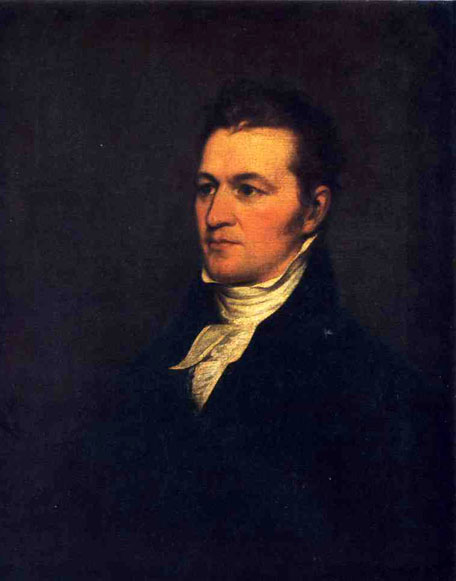
Samuel Miles Hopkins: 1805
Samuel Miles Hopkins (May 9, 1772 - March 9, 1837) was a United States Representative from New York. Born in Salem, Connecticut, he graduated from Yale College in 1791, studied law, was admitted to the bar and commenced practice in Le Roy, Genesee County, New York in 1793. He moved to New York City in 1794 and continued the practice of law.
Hopkins was elected as a Federalist to the Thirteenth Congress, holding office from March 4, 1813 to March 3, 1815. He was a member of the New York State Assembly (Genesee Co.) in 1820-21; and of the New York State Senate (Western D.) in 1822. From 1813 to 1826, he was Reporter of the New York Court of Chancery. He was a member of the commission to superintend the construction of Sing Sing Prison from 1825 to 1830 and was a judge of the State circuit court 1832 to 1836. Hopkins died in Geneva, Ontario County in 1837; interment was in Washington Street Cemetery.
Sarah Elizabeth Rogers Hopkins: ca 1805
Sarah Trumbull with a Spaniel: 1802
Self Portrait: ca 1802
The Misses Mary and Hannah Murray: 1802
The Vernet Family: 1806
The Young Sachem, A Chief of the Six Nations: 1792
"The Young Sachem," an unidentified Indian chief, was a deputy from the Six Nations, a confederation of Iroquois tribes, who conferred with Congress in Philadelphia in 1792 during diplomatic efforts to end conflicts with Indians in the Northwest Territory.
Sarah Trumbull on her Deathbed: 1824
Theodore Dwight: 1828
Thomas Jefferson: 1788
Thomas Pickney: 1791
Thomas Pinckney, a Representative from South Carolina; born in Charleston, S.C., October 23, 1750; attended Westminster School, Oxford, England, and was graduated from Oxford University, England; also attended the French Military College, Caen, France, for one year; studied law at the Inner Temple, London; was admitted to the bar in 1774 and commenced practice in Charleston, S.C.; captain of Engineers, First Regiment, Continental Army, in 1775; major in the Florida campaign in 1778; served under Gen. Benjamin Lincoln in 1778 and 1779 and with Count d'Estaing in 1779; served in the defense of Charleston; Governor of South Carolina 1787-1789; presided over the State ratification convention in 1788; member of the State house of representatives in 1791; United States Minister to Great Britain from January 12, 1792, to July 28, 1796; also Envoy Extraordinary to Spain from November 24, 1794, to November 1795 and negotiated the treaty settling the boundary between the United States and East and West Florida and between the United States and Louisiana; elected as a Federalist to the Fifth Congress to fill the vacancy caused by the resignation of William L. Smith; reelected to the Sixth Congress and served from November 23, 1797, to March 3, 1801; one of the managers appointed by the House of Representatives in 1798 to conduct the impeachment proceedings against William Blount, a Senator from Tennessee; resumed the practice of law and also engaged in agricultural pursuits; appointed major general in the War of 1812 and served throughout the war; president general of the Society of the Cincinnati 1825-1828; died in Charleston, S.C., November 2, 1828; interment in St. Philip's Churchyard.
Non-Revolutionary War Works of John Trumbull
The Death of Paulus Aemilius at the Battle of Cannae: 1773
The Earl of Angus Conferring Knighthood on De Witton: 1810
Priam Returning to his Family with the Dead Body of Hector: 1785
The Woman Taken in Adultery: 1811
There is much that could and should be added to this project but much time has been given to it and fatigue is beginning to overpower me preventing a will and a desire to continue where physical weakness inhibits me. I have discovered a site that is a depository and a rich resource for digital art from the New York Public Library. They are copies from John Trumbull's Works: prints, etchings, and engravings of much of his work.
NYPL Digital Gallery
Alexander Hamilton
Battle of Bunker Hill
Brigadier General Anthony Wayne
Charles Cotesworth Pickney
Christopher Gore
Daniel Morgan
De Witt Clinton
Death of General Montgomery
Death of General Warren
George Washington
George Washington Resigning his Commission
George Washington
George Washington
George Washington
George Washington
George Washington: 1790
Governor George Clinton
Hugh Williamson, M.D., L.L.D.
John Langdon
John Rutledge
Josiah Bartlett
Major General Israel Putnam
Major General Nathaniel Greene
Major General Thomas Pinckney
Major General William Moultrie
Mrs. Charles Carroll
Oliver Ellswoth
Oliver Ellsworth, Esq., late Chief Justice of the United States
Philip Schuyler
Robert Hanson Harrison
Samuel Osgood, member of the Continental Congress
Samuel Osgood a Delegate from Massachusetts; born in Andover, Essex County, Mass., February 3, 1748; was graduated from Harvard College in 1770; studied theology; engaged in mercantile pursuits; delegate to the Essex County convention in 1774; member of the Provincial Congress; entered the Revolutionary Army as captain and left the service as colonel and assistant quartermaster; Member of the Continental Congress 1781-1784; member of the state senate, 1780; member of the state house of representatives in 1784; a commissioner of the United States Treasury 1785-1789; Postmaster General in the administration of President Washington 1789-1791; moved to New York City; member of the state assembly 1800-1803; Supervisor of Internal Revenue for the District of New York; appointed naval officer at the port of New York May 10, 1803, and served until his death, August 12, 1813; interment in the Brick Presbyterian Church, Nassau and Beekman Streets (now Fifth Avenue and Thirty-seventh Street), New York City.
Surrender of Lord Cornwallis, at Yorktown. VA. - Oct. 19, 1781
The Battle of Trenton
Related Sources:
This page is the work of Senex Magister
Return to Pagina Artis
Return to Bruce and Bobbie's Main Page.
